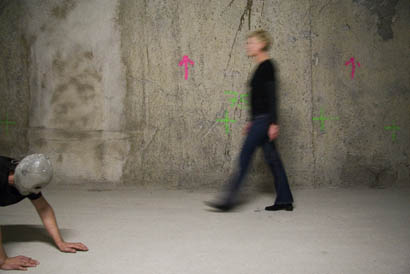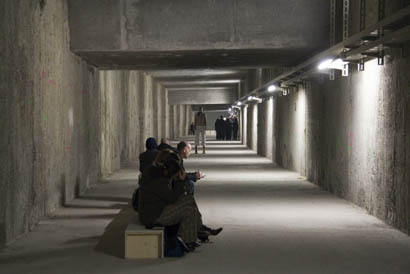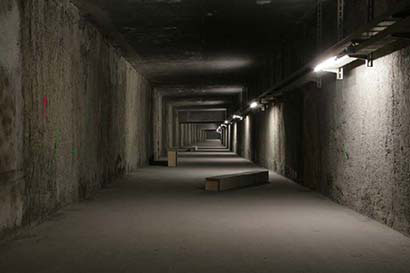theatercombinat | 06.12.- 19.12.2006 die perser aischylos/müller/witzmann – tragic chorus of the 12, void under mariahilfer straße, wien (a) |
|
workingmodel: |
parallel to the production of the «persians» in geneve, theatercombinat worked out experimentally for over 6 months a moving and talking chorus of citizens, based on the model of the ancient tragedy chorus, consisting of 12 citizens of the city of athens. location: an emtpy 200 m long and 6 m broad subterranean tunnel - an urban (transition space) without any function. a choreography of bodies, language and thoughts in a space under the city of vienna. the audience becomes the witness and participant of the moving chorus, the acoustic and installation-based sit-in and the process of «phonetic thinking» in space. |
 photo: maria mäser photo: maria mäser
|
concept/staging/score: claudia bosse, envoy: gerald singer, atossa/xerxes: doris uhlich, shade of dareios: christine standfest, small chorus: aurelia burckhardt, gerald singer, christine standfest, doris uhlich, chorus of the 12: beatrix brunner, aurelia burckhardt, gerlinde egger, brigitte futscher, ulrike johannsen, dora müller, heidemarie pichler, ingrid racz, ana szilagyi, ilse urbanek, lena wicke, bauten: karoline streeruwitz/sammerstreeruwitz, christian teckert/as-if, production: ani mezaduryan, lena wicke void under the mariahilfer straße, vienna, premiere 6.12.2006, 7 performances 1.4.2007 radio version of «die perser» in ORF kunstradio, werner möbius and theatercombinat supported by wien kultur, wiener linien and firma blitz blank |
(...) a text is a linear presence of time, because nearly always it is something written in succession. this linearity constitutes the medium and furthermore scans the time. the actual moment when something is said in a sentence is important. i am not interested in the whole content of the sentence during the utterance, but which word follows which, which choreography of thinking comes into being. the point is to grasp the course of a sentence, its ways and its entanglements, and also to activate the possibilities of a different course, to bear in mind a possible sense, that could follow, but is jointed specifically by the next word. the point is, not to anticipate the sense of a sentence, but to explore it "word by word". to render this exploration material and theatrical, the body of every single word has to be grasped: its syllables, the sequence of consonants and vowels, exploring which movement is produced in the mouth, in the utterance, in the space, while breathing. in following a written text, the phonetic thinking attempts to grasp every word in its body, and passages to each following word, etc. while talking and to produce the thinking of a word in sound, that happens to become the sentence by uttering and charging the room. the thinking becomes material and theatrical. the score developed for the stagings of the persians, is a specific approach towards language and speaking. a kind of proportional, phonetic speech grammar, that produces mental attributive rules for the speaker, who has to produce them at the moment and guide this continuity to the end of the sentence or the verse. this speech attempts to synchronyze thinking, the phonetic production of the speakers and the listening of the recipients. the timings and the articulation arise from the respective room acoustics and the time, that the sound requires to spread in space. the scansion insists on the present in the moment of speaking. the sense of the sentence emerges in hearing via the continuity of the following and is not anticipated in the moment of speaking. in speaking, every syllable is grasped and articulated. in each case the consonants form the gravity of the words, that means: they must be grasped and released. the heights of the articulation of the consonants are not affected by the following or the former vowels. (...) |
claudia bosse:
|
 |
www.theatercombinat.com theatrale produktion und rezeption
